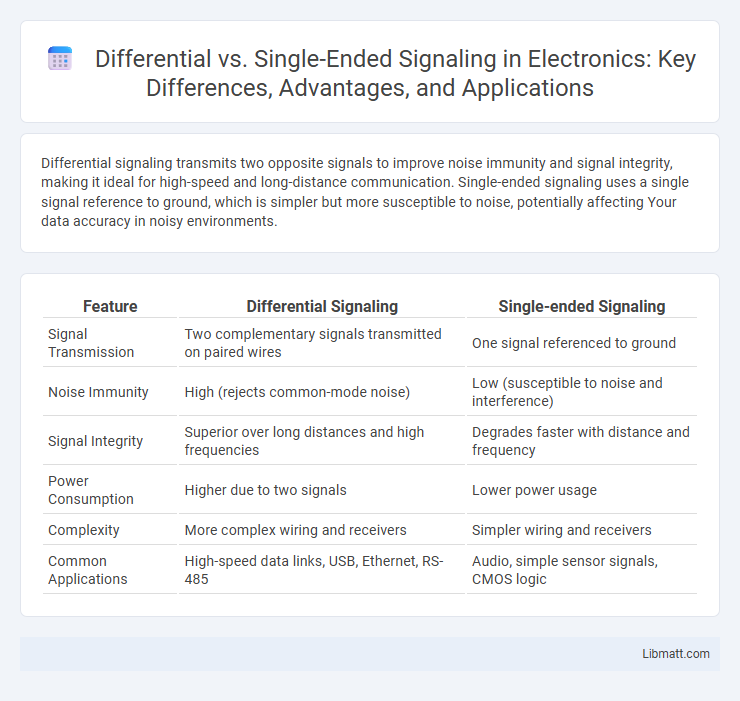Differential signaling transmits two opposite signals to improve noise immunity and signal integrity, making it ideal for high-speed and long-distance communication. Single-ended signaling uses a single signal reference to ground, which is simpler but more susceptible to noise, potentially affecting Your data accuracy in noisy environments.
Table of Comparison
| Feature | Differential Signaling | Single-ended Signaling |
|---|---|---|
| Signal Transmission | Two complementary signals transmitted on paired wires | One signal referenced to ground |
| Noise Immunity | High (rejects common-mode noise) | Low (susceptible to noise and interference) |
| Signal Integrity | Superior over long distances and high frequencies | Degrades faster with distance and frequency |
| Power Consumption | Higher due to two signals | Lower power usage |
| Complexity | More complex wiring and receivers | Simpler wiring and receivers |
| Common Applications | High-speed data links, USB, Ethernet, RS-485 | Audio, simple sensor signals, CMOS logic |
Introduction to Signal Transmission Methods
Differential signaling transmits data using two complementary voltage signals, improving noise immunity and reducing electromagnetic interference compared to single-ended signaling, which sends a signal referenced to a common ground. This approach enhances signal integrity in high-speed data communication systems such as USB, Ethernet, and PCIe. Single-ended signaling remains common in lower-speed or simpler circuits due to its straightforward design and lower cost.
Understanding Single-ended Signaling
Single-ended signaling uses one wire to carry the signal voltage referenced to a common ground, making it simpler and cost-effective for short-distance or low-speed communications. Your signal quality in single-ended systems can be susceptible to noise and electromagnetic interference due to the single reference point, leading to potential data integrity issues. Despite these limitations, single-ended signaling remains widely used in devices with less stringent noise immunity requirements and straightforward circuit designs.
Principles of Differential Signaling
Differential signaling transmits two complementary signals over a pair of wires, where the information is represented by the voltage difference between them, effectively canceling common-mode noise and enhancing signal integrity. This technique significantly reduces electromagnetic interference (EMI) and crosstalk compared to single-ended signaling, which uses a single wire referenced to ground, making differential signaling ideal for high-speed and noise-sensitive applications. Your system benefits from improved noise immunity and signal accuracy when utilizing differential signaling principles in communication protocols.
Key Differences Between Differential and Single-ended Signaling
Differential signaling transmits two complementary signals over paired conductors, enhancing noise immunity and minimizing electromagnetic interference, while single-ended signaling sends one signal referenced to a common ground, making it more susceptible to noise. Differential signals offer higher data integrity and longer transmission distances, especially in noisy environments such as industrial or automotive applications. Single-ended signaling is simpler and cost-effective for short-distance communication with less stringent noise requirements.
Signal Integrity and Noise Immunity Comparison
Differential signaling offers superior signal integrity by transmitting two complementary signals, which helps cancel out electromagnetic interference and minimizes crosstalk. Single-ended signaling, with a single reference voltage line, is more susceptible to noise and signal degradation over long distances or through high-frequency environments. Consequently, differential signaling provides enhanced noise immunity and more reliable data transmission in electrically noisy conditions.
Applications of Single-ended Signaling
Single-ended signaling is commonly used in low-speed, short-distance communication systems such as analog audio, telemetry, and simple microcontroller interfaces. Devices like UARTs, I2C buses, and TTL logic circuits often rely on single-ended signals due to their simplicity and reduced wiring complexity. This signaling method is well-suited for environments with minimal electrical noise and where cost-effective, straightforward design is prioritized.
Applications of Differential Signaling
Differential signaling is widely used in high-speed data communication systems such as Ethernet, USB, HDMI, and PCI Express due to its superior noise immunity and reduced electromagnetic interference (EMI). This method is essential in automotive and industrial environments where signal integrity is critical amidst electrical noise. Single-ended signaling is more common in simpler or short-distance applications like audio equipment and basic analog sensors, where cost and complexity are minimized.
Cost and Complexity Considerations
Differential signaling requires pairs of wires and more complex receiver circuits, which can increase both material and manufacturing costs compared to single-ended signaling using a single conductor and ground. The additional circuitry and precise matching of differential pairs add to design complexity, often necessitating more sophisticated PCB layouts and higher-quality components. Your choice between differential and single-ended signaling should weigh these cost and complexity factors against the performance benefits needed for your application.
Performance Impact on Data Rates and Distances
Differential signaling significantly enhances data rates and transmission distances by reducing electromagnetic interference (EMI) and crosstalk, enabling more reliable high-speed communication compared to single-ended signaling. Single-ended signaling is more susceptible to noise and signal degradation over longer distances, limiting its effective bandwidth and data integrity. Consequently, differential signaling is preferred in high-frequency applications such as USB 3.0, Ethernet, and PCIe, where maintaining signal quality over extended cable lengths is critical.
Choosing the Right Signaling Method for Your Application
Choosing the right signaling method depends on factors such as noise immunity, signal integrity, and transmission distance. Differential signaling offers superior noise rejection and is ideal for high-speed or long-distance data transmission, while single-ended signaling is simpler and cost-effective for short-range, low-speed applications. Your decision should balance performance requirements and system complexity to ensure optimal communication reliability.
Differential vs Single-ended signaling Infographic

 libmatt.com
libmatt.com